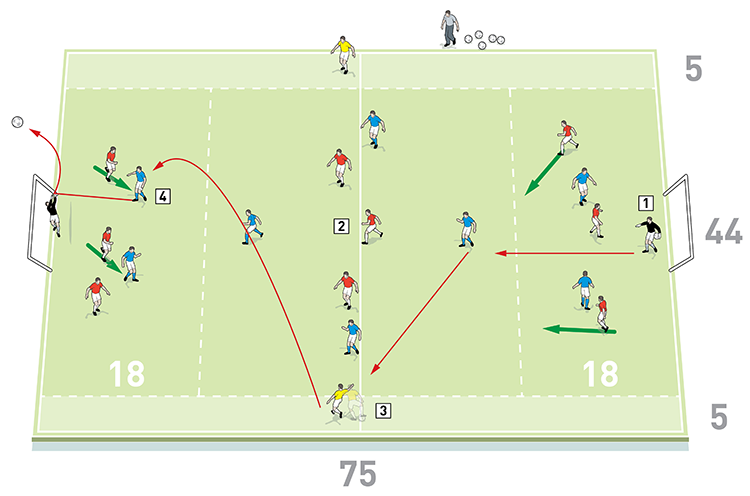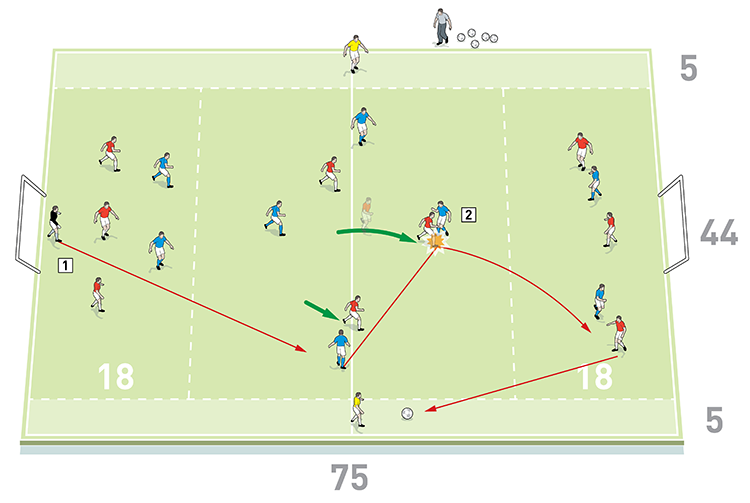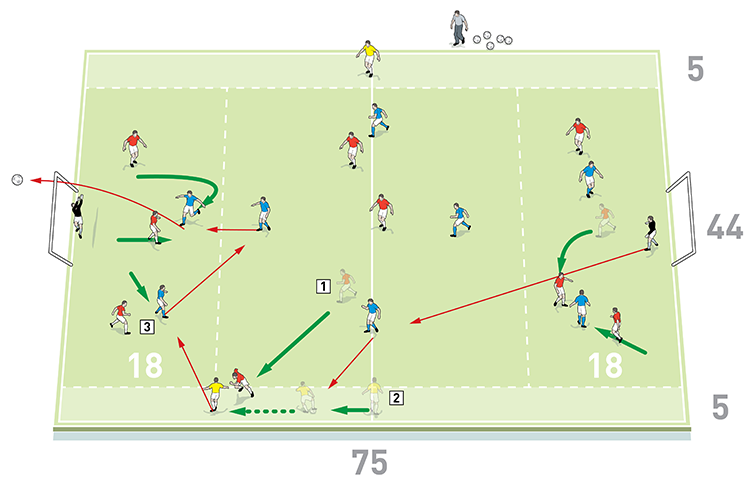You are viewing 1 of your 1 free articles
This session is all about developing play in the attacking third and coaching players to finish from balls crossed into the penalty area. We would run this as a full squad practice, so although the focus would be on finishing from crosses, the defensive and midfield units within the team would get some specific work from the session too.
| Area | Up to full pitch |
| Equipment | Balls, bibs, cones, 2 goals |
| No. of Players | 19 players + 2 goalkeepers |
| Session Time |
Attacking the final third: 20mins 11v11 game: 20mins |
This session is all about developing play in the attacking third and coaching players to finish from balls crossed into the penalty area. We would run this as a full squad practice, so although the focus would be on finishing from crosses, the defensive and midfield units within the team would get some specific work from the session too.
It is so important that players get to experience realistic match situations in training and this practice allows that to happen. We would run this a couple of times in each 12-week block of work. It may also form part of our carousel practice on a Saturday morning, when we usually have three activities going on with different age groups – one working on their individual learning plans, one running through a phase of play on the weekly theme, and one performing this finishing practice.
What do I get the players to do?
Attacking the final third
We set up a main area of 75x44 yards, with a full size goal and goalkeeper at each end. An 18-yard end zone is marked in front of each goal with a large central zone between them. There is an additional five-yard wide channel on each flank. We’re using 19 outfield players divided into an attacking team of eight and a defending team of nine, plus two neutral wide players. Only the neutral players are allowed in the wide channels and they are initially limited to two-touch.
The blue attacking team is set up with four players in a midfield diamond in the central zone and it has two strikers in each end zone. The attacking team plays in either direction and can score in both goals but players are locked in their zones. Play starts and restarts with a keeper playing into the attacking team in the midfield zone, and as soon as a blue midfielder touches the ball, play is live, as shown [1a]. The objective for the attacking team is to create opportunities to score from crosses, which should be played in by the neutrals from the wide channels.
1a

2. The red defending team has three players locked in each of the three main zones
3. Only the neutral players are allowed in the wide channels and they are limited to two-touch
4. The blue attacking team must try to score from crosses played in by the neutrals from the wide channels
The red defending team has three players locked in each of the three main zones and they must defend against the blues. If they win the ball, they should pass to either of the keepers or the wingers, as shown [1b], and then play stops.
1b

2. If the defending team wins the ball, they should pass to either of the keepers or the neutral wingers and play stops
If the ball goes dead, alternate the end that play restarts from.
How do I progress the activity?
To progress the activity, we allow one defender to go into the wide channels to apply pressure to the wide player, as shown [1c]. To progress it further we can remove the touch restriction that limits the neutrals to two touches.
1c

2. Further progress the activity by removing the two-touch restriction on wide players
3. If scoring from a cross is not possible, players can recycle the ball and start again
What are the key things to look out for?
If an opportunity doesn’t arise to create a scoring chance, we want to see players using midfield rotation to retain possession of the ball. We also want to see the neutral wingers supporting play in relation to the position of the ball, and if the wingers get as high up the pitch as the attacking third, we want to see them make decisions about whether to cross or cut the ball back. If the wingers shape to cross the ball, we want to see good movement from the strikers and supporting runs from the midfielders.
What are the typical mistakes players might make and how do I avoid them?
Sometimes attacking players make runs without checking where the cross is being played to. We remedy this by ensuring players know they should slow their runs and make late adjustments based on the flight of the ball.
Another common mistake occurs when crossing players hit the ball into the middle without making sure that forwards are in a good position to finish. The coaches should use this as an opportunity to remind players to look up before they cross the ball.
How would I put this into a game situation?
11v10 game
We set up for a game between the two penalty boxes, using the full width of the pitch. We position a goal and a goalkeeper at each end. We’re using 19 outfield players set up as shown [2], with a blue attacking team of 10 outfield players taking on a red defending team of 9 outfield players. Normal rules apply, including offsides, but play starts and restarts from the attacking team’s goalkeeper. We encourage wide players to make overlapping or underlapping runs to get into the position to make effective crosses.
We also want to see good movement from the strikers, who should time their runs well and make positional adjustments to match the angle of the delivery.
Related Files
Editor's Picks
Using the goalkeeper in build-up play
Pressing principles
Intensive boxes drill with goals
Penetrating the final third
Creating and finishing
My philosophy
Pressing initiation
Compact team movement
Defensive organisation
Coaches' Testimonials

Alan Pardew

Arsène Wenger

Brendan Rodgers

Carlos Carvalhal

José Mourinho

Jürgen Klopp

Pep Guardiola

Roy Hodgson

Sir Alex Ferguson

Steven Gerrard
Coaches' Testimonials

Gerald Kearney, Downtown Las Vegas Soccer Club

Paul Butler, Florida, USA

Rick Shields, Springboro, USA

Tony Green, Pierrefonds Titans, Quebec, Canada
Join the world's leading coaches and managers and discover for yourself one of the best kept secrets in coaching. No other training tool on the planet is written or read by the calibre of names you’ll find in Elite Soccer.
In a recent survey 92% of subscribers said Elite Soccer makes them more confident, 89% said it makes them a more effective coach and 91% said it makes them more inspired.
Get Monthly Inspiration
All the latest techniques and approaches
Since 2010 Elite Soccer has given subscribers exclusive insight into the training ground practices of the world’s best coaches. Published in partnership with the League Managers Association we have unparalleled access to the leading lights in the English leagues, as well as a host of international managers.
Elite Soccer exclusively features sessions written by the coaches themselves. There are no observed sessions and no sessions “in the style of”, just first-hand advice delivered direct to you from the coach.









